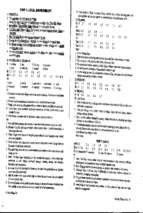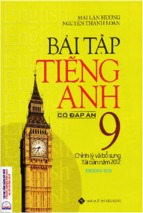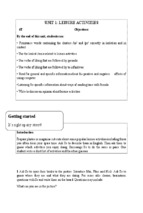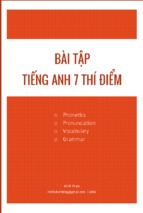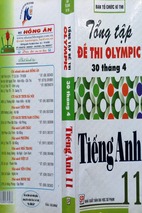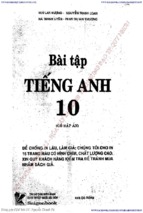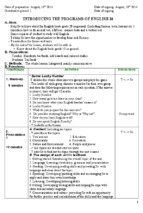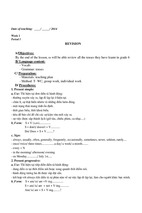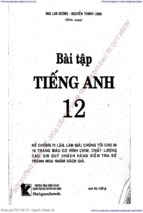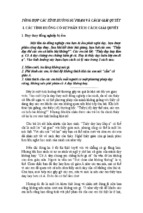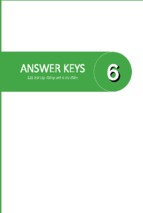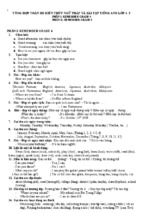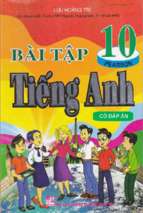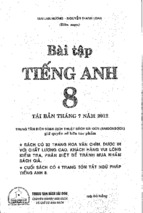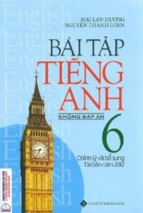ĐỀ THI THỬ CÓ LỜI GIẢI CHI TIẾT
SƯU TẦM
Truy cập diendan.hocmai.vn để tải nhiều tài liệu hơn!
ĐỀ THI THỬ SỐ 07
Mark the letter A, B, C or D on your answer sheet to indicate the word whose underlined part
differs from the other three in pronunciation in each of the following questions
Question 1:
A. loved
B. missed
C. stopped
D. received
Question 2:
A. species
B. invent
C. medicine
D. tennis
Mark the letter A, B, C or D on your answer sheet to indicate the word that differs from the
other three in the position of primary stress in each of the following questions.
Question 3:
A. comfortable
B. attractive
C. secretive
D. necessary
Question 4:
A. include
B. achieve
C. replace
D. comment
Mark the letter A, B, C or D on your answer sheet to indicate the word whose underlined part
that needs correction in each of the following questions.
Question 5: Despite Hoa worked very hard, she didn’t pass the exam.
A. Despite
B. hard
C. didn’t
D. exam
Question 6: Both Tuan and Thanh has been to Paris before.
A. Both
B. and
C. has
D. before
Question 7: They was told to plan everything very carefully before the journey.
A. was
B. everything
C. carefully
D. journey
Mark the letter A, B, C or D on your answer sheet to indicate the correct answer to each of the
following questions.
Question 8: At present, the new director_______to foster a culture of open cummunication
within the company.
A. tried
B. was trying
C. is trying
D. tries
Question 9: A recent survey has shown that______ increasing number of men are willing to
share the housework with their wives.
A. a
B. an
C. the
D. some
Question 10: ______he worked, the more he earned.
A. The more hard
B. The hard
C. The harder
D. The hardest
Cảm ơn bạn đã tải tài liệu từ diễn đàn HOCMAI – Cộng đồng học tập lớn nhất Việt Nam |1
ĐỀ THI THỬ CÓ LỜI GIẢI CHI TIẾT
SƯU TẦM
Truy cập diendan.hocmai.vn để tải nhiều tài liệu hơn!
Question 11: Long wanted to know_________in my family.
A. there were how many people
B. how many people were there
C. were there how many people
D. how many people there were
Question 12: Richard had to pay a fine,_____?
A. hadn’t he
B. doesn’t he
C. didn’t he
D. mustn’t he
Question 13: Pupils are ______ less pressure as a result of changes in testing procedures.
A. .out of
B. above
C. upon
D. under
Question 14: We should__________every chance we have to speak English.
A. Make use of
B. make a use of
C. make uses of
D. make the use of
Question 15: Dr. Fleming, _______discovered penicillin, was awarded the Nobel Prize of
Medicine in 1945.
A. that
B. which
C. whom
D. who
Question 16: A large number of reporters_____________ at the meeting yesterday.
A. being
B. are
C. were
D. is
Question 17: Many countries’ cutural ____________is a result of talking in immigrants from all
over the world.
A. diversified
B. diversity
C. diverse
D. diversify
Question 18: Shy people often find it difficult to_______group discussion.
A. take part in
B. take place in
C. get on with
D. get in touch with
Question 19: He was tired and couldn’t keep________the group.
A. out of
B. up against
C. on to
D. up with
Mark the letter A, B, C or D on your answer sheet to indicate the most suitable response to
complete each of the following exchanges.
Question 20: Two friends Joan and Jane are talking about Jane’s new dress.
- Diana: That’s a very nice dress you’re wearing.
- Jane:____________ .
A. Never mind.
B. Don’t mention it.
C. Thanks. I’m glad you like it.
D. You’re welcome.
Question 21: Lien: “ Are you Japanese?”
A. Sorry?
B. Pardon?
- Hung : “____________________”.
C. Excuse me
D. Yes?
Cảm ơn bạn đã tải tài liệu từ diễn đàn HOCMAI – Cộng đồng học tập lớn nhất Việt Nam |2
ĐỀ THI THỬ CÓ LỜI GIẢI CHI TIẾT
SƯU TẦM
Truy cập diendan.hocmai.vn để tải nhiều tài liệu hơn!
Mark the letter A, B, C or D on your answer sheet to indicate the word(s) CLOSEST in
meaning to the underlined word(s) in ecah of the following questions.
Question 22: I’ll take the new job whose salary is fantastic.
A. reasonable
B. acceptable
C. pretty high
D. wonderful
Question 23: He was asked to account for his presence at the scene of crime.
A. complain
B. exchange
C. explain
D. arrange
Mark the letter A, B, C or D on your answer sheet to indicate the word(s) OPPOSITE in
meaning to the underlined word(s) in ecah of the following questions.
Question 24: “ Be quick! We must speed up if we don’t want to miss the flight”
A. slow down
B. turn down
C. put forward
D. look up
Question 25: He had never experienced such discourtesy towards the president as it occurred.
A. rudeness
B. politeness
C. measurement
D. encouragement
Mark the letter A, B, C or D on your answer sheet to indicate the sentence that is closest in
meaning to each of the followingquestions.
Question 26: The architect has drawn plans for an extension to the house.
A. Plans have been drawn for an extension to the house by the architect.
B. The house has had its plans for an extension drawn by the architect.
C. Plans for an extension to the house have been drawn by the architect.
D. The architect has had the plans drawn for an extension to the house.
Question 27: I didn’t eat anything because I wasn’t hungry.
A. If I was hungry, I would eat something.
B. If I had been hungry, I would have eaten something.
C. If I hadn’t been hungry, I would have eaten something.
D. If I had eaten something, I would have been eaten something.
Question 28: “ What would you do if you were a billionaire?” the man asked the woman.
A. The man asked the woman what she would do if she were a billionaire.
B. The man asked the woman what she would have done if she were a billionaire.
C. The man asked the woman what would she do if she were a billionaire.
Cảm ơn bạn đã tải tài liệu từ diễn đàn HOCMAI – Cộng đồng học tập lớn nhất Việt Nam |3
ĐỀ THI THỬ CÓ LỜI GIẢI CHI TIẾT
SƯU TẦM
Truy cập diendan.hocmai.vn để tải nhiều tài liệu hơn!
D. The man asked the woman what would she have done if she had been a billionaire.
Mark the letter A, B, C or D on your answer sheet to indicate the sentence that best combines
each pair of sentences in the following questions.
Question 29: The plants may develop differently. The plants live on that island.
A. The plants which live on that island may develop differently.
B. The plants lives on that island may develop differently.
C. The plants which lives on that island may develop differently.
D. The plants which live that island may develop differently.
Question 30: My mother is very busy at work but she takes good care of her children.
A. In spite of being busy at work, my mother takes good care of her children.
B. My mother takes good care of her children but she is very busy at work.
C. Though my mother was very busy at work my mother took good care of her children.
D. Although my mother was very busy at work she did not take good care of her children.
Read the following passage and mark the letter A, B, C or D on your answer sheet to indicate
the correct word or phrase that best fits each of the numbered blanks from 31 to 35.
My home is in the air – I do an enormous amount of travelling. It is a fast life and full of work,
but I like it and that is the only way (31)..................me.
Everything is tiring – music, travelling – but what can I do? I am not (32).................to
complaining. It is hart to imagine now that I will never be very long in one place. My home town
is on the Caspian Sea. There is sea, wind, sun and too many tourists and hotels. I have my own
flat with four or five rooms. But I am seldom there. If I am there for a day or two I prefer to
(33)................ with my mother and grandmother. They live in a small house, but it is very
comfortable and my mother cooks for me. I like good, simple food.
I have no wife, no brothers or sisters and my father died when I was seven. He was an engineer
and I don’t ( 34).............him very well. He liked music very much and wanted me to
(35)..............a musician.
Question 31:
A. for
B. to
C. in
D. by
Question 32:
A. wanted
B. taken
C. used
D. known
Question 33:
A. stay
B. go
C. do
D. spend
Cảm ơn bạn đã tải tài liệu từ diễn đàn HOCMAI – Cộng đồng học tập lớn nhất Việt Nam |4
ĐỀ THI THỬ CÓ LỜI GIẢI CHI TIẾT
SƯU TẦM
Truy cập diendan.hocmai.vn để tải nhiều tài liệu hơn!
Question 34:
A. know
B. remember
C. remind
D. see
Question 35:
A. grow
B. turn
C. develop
D. become
Read the following passage and mark the letter A, B, C or D on your answer sheet to indicate
the correct answer to each of the questions from 36 to 42.
By adopting a few simple techniques, parents who read to their children can considerably
increase their children’s language development. It is surprising, but true. How parents talk to
their children makes a big difference in the children's language development. If a parent
encourages the child to actively respond to what the parent is reading, the child's language skills
increase.
A study was done with two or three-year-old children and their parents. Half of the thirty
children participants were in the experimental study; the other half acted as the control group. In
the experimental group, the parents were given a two-hour training session in which they were
taught to ask open-ended questions rather than yes-no questions. For example, the parent should
ask, "What is the doggy doing?" rather than, "Is the doggy running away?" Experimental parents
were also instructed how to expand on their children's answer, how to suggest alternative
possibilities, and how to praise correct answers.
At the beginning of the study, the children did not differ on levels of language development, but
at the end of one month, the children in the experimental group were 5.5 months ahead of the
control group on a test of verbal expression and vocabulary. Nine months later, the children in
the experimental group still showed an advance of 6 months over the children in the control
group.
Question 36: Parents can give great help to their children's language development by _____ them.
A. adopting
B. responding to
C. experimenting
D. reading to
Question 37: What does the word "they" in the second paragraph refer to?
A. Participants.
B. Questions.
C. Children.
D. Parents.
Question 38: During the training session, experimental parents were taught to _____.
A. study many experiments
B. use yes-no questions
C. give correct answers
D. ask open-ended questions
Question 39: What was the major difference between the control group and the experimental
one in the study?
Cảm ơn bạn đã tải tài liệu từ diễn đàn HOCMAI – Cộng đồng học tập lớn nhất Việt Nam |5
ĐỀ THI THỬ CÓ LỜI GIẢI CHI TIẾT
SƯU TẦM
Truy cập diendan.hocmai.vn để tải nhiều tài liệu hơn!
A. The training that parents received.
B. The books that were read.
C. The age of the children.
D. The number of participants.
Question 40: What conclusion can be drawn from this passage?
A. Children who read actively always act six months earlier than those who don't.
B. Children's language skills increase when they are required to respond actively.
C. Two or three-year-old children can be taught to read actively.
D. The more children read, the more intelligent they become.
Question 41: Which was done with two or three – year – old children and their parents?
A. a party
B. a study
C. a meeting
D. a control group
Question 42: When did the chilren similar on levels of language development?
A. at the middle of the study
B. at the end of the study
C. at the beginning of the age
D. at the beginning of the study
Read the following passage and mark the letter A, B, C or D on your answer sheet to indicate
the correct answer ti each of the questions from 43 to 50.
The issue of equality for women in British society first attracted national attention in the
early 20th century, when the suffragettes won for women the right to vote. In the 1960s
feminism became the subject of intense debate when the women’s liberation movement
encouraged women to reject their traditional supporting role and to demand equal status
and equal rights with men in areas such as employment and pay. Since then, the gender
gap between the sexes has been reduced. The Equal Pay Act of 1970, for instance, made
it illegal for women to be paid less than men for doing the same work, and in 1975 the
Sex Discrimination Act aimed to prevent either sex having an unfair advantage when
applying for jobs. In the same year the Equal Opportunities Commission was set up to
help people claim their rights to equal treatment and to publish research and statistics to
show where improvements in opportunities for women need to be made. Women now
have much better employment opportunities, though they still tend to get less well-paid
jobs than men, and very few are appointed to top jobs in industry. In the US the
movement that is often called the “first wave of feminism” began in the mid 1800s. Susan
B. Anthony worked for the right to vote, Margaret Sanger wanted to provide women with
Cảm ơn bạn đã tải tài liệu từ diễn đàn HOCMAI – Cộng đồng học tập lớn nhất Việt Nam |6
ĐỀ THI THỬ CÓ LỜI GIẢI CHI TIẾT
SƯU TẦM
Truy cập diendan.hocmai.vn để tải nhiều tài liệu hơn!
the means of contraception so that they could decide whether or not to have children, and
Elizabeth Blackwell, who had to fight for the chance to become a doctor, wanted women
to have greater opportunities to study. Many feminists were interested in other social
issues. The second wave of feminism began in the 1960s. Women like Betty Friedan and
Gloria Steinem became associated with the fight to get equal rights and opportunities for
women under the law. An important issue was the Equal Rights Amendment (ERA),
which was intended to change the Constitution. Although the ERA was not passed, there
was progress in other areas. It became illegal for employers, schools, clubs, etc. to
discriminate against women. But women still find it hard to advance beyond a certain
point in their careers, the so-called glass ceiling that prevents them from having highlevel jobs. Many women also face the problem of the second shift, i.e. the household
chores. In the 1980s, feminism became less popular in the US and there was less interest
in solving the remaining problems, such as the fact that most women still earn much less
than men. Although there is still discrimination, the principle that it should not exist is
widely accepted.
Question 43: It can be inferred from paragraph 1 that in the 19th century, ______.
A. British women did not have the right to vote in political elections
B. most women did not wish to have equal status and equal rights
C. suffragettes fought for the equal employment and equal pay
D. British women did not complete their traditional supporting role
Question 44: The phrase “gender gap” in paragraph 2 refers to ______.
A. the social relationship between the two sexes
B. the visible space between men and women
C. the social distance between the two sexes
D. the difference in status between men and women
Question 45: Susan B. Anthony, Margaret Sanger, and Elizabeth Blackwell are mentioned as __.
A. American women who were more successful than men
B. American women who had greater opportunities
C. pioneers in the fight for American women’s rights
D. American women with exceptional abilities
Cảm ơn bạn đã tải tài liệu từ diễn đàn HOCMAI – Cộng đồng học tập lớn nhất Việt Nam |7
ĐỀ THI THỬ CÓ LỜI GIẢI CHI TIẾT
SƯU TẦM
Truy cập diendan.hocmai.vn để tải nhiều tài liệu hơn!
Question 46: The Equal Rights Amendment (ERA) ______.
A. supported employers, schools and clubs
B. changed the US Constitution
C. was brought into force in the 1960s
D. was not officially approved
Question 47: In the late 20th century, some information about feminism in Britain was issued by
______.
A. the Equal Rights Amendment
B. the Equal Pay Act of 1970
C. the Equal Opportunities Commission
D. the Sex Discrimination Act
Question 48: Which of the following is true according to the passage?
A. The US movement of feminism became the most popular in the late 20th century.
B. The British government passed laws to support women in the early 20th century.
C. The women’s liberation movement in the world first began in Britain.
D. The movement of feminism began in the US earlier than in Britain.
Question 49: The phrase “glass ceiling” in paragraph 4 mostly means ______.
A. a ceiling made of glass
B. an imaginary barrier
C. a transparent frame
D. an overlooked problem
Question 50: Which of the following is NOT mentioned in the passage?
A. An American woman once had to fight for the chance to become a doctor.
B. British women now have much better employment opportunities.
C. There is now no sex discrimination in Britain and in the US.
D. Many American women still face the problem of household chores.
........................THE END.......................
Đáp án
1-D
2-A
3-B
4-D
5-A
6-C
7-A
8-C
9-B
10-C
11-D
12-C
13-D
14-A
15-D
16-C
17-B
18-A
19-D
20-C
21-D
22-C
23-C
24-A
25-B
26-C
27-B
28-A
29-A
30-A
31-A
32-C
33-A
34-B
35-D
36-D
37-D
38-D
39-A
40-B
41-B
42-D
43-A
44-D
45-C
46-D
47-C
48-D
49-B
50-C
Cảm ơn bạn đã tải tài liệu từ diễn đàn HOCMAI – Cộng đồng học tập lớn nhất Việt Nam |8
ĐỀ THI THỬ CÓ LỜI GIẢI CHI TIẾT
SƯU TẦM
Truy cập diendan.hocmai.vn để tải nhiều tài liệu hơn!
Cảm ơn bạn đã tải tài liệu từ diễn đàn HOCMAI – Cộng đồng học tập lớn nhất Việt Nam |9
ĐỀ THI THỬ CÓ LỜI GIẢI CHI TIẾT
SƯU TẦM
Truy cập diendan.hocmai.vn để tải nhiều tài liệu hơn!
LỜI GIẢI CHI TIẾT
Question 1: D
Phần D phát âm là /d/ các phần còn lại phát âm là /t/
Đuôi /ed/ được phát âm là /id/ khi động từ có phát âm kết thúc là /t/ hay /d/
Đuôi /ed/ được phát âm là /t/ khi động từ có phát âm kết thúc là /s/,/f/,/p/,/ʃ/,/tʃ/,/k/
Đuôi /ed/ được phát âm là /d/ với các trường hợp còn lại
Question 2: A
species /'spi:∫i:z/
invent /in'vent/
medicine /'medsn/ hoặc /'medisn/
tennis /tenis/
Question 3: B
Phần B trọng âm rơi vào âm tiết thứ 2, còn lại là thứ nhất
comfortable /'kʌmftəbl/ hoặc /'kʌmfətəbl/
attractive /ə'træktiv/
secretive /'si:krətiv/
necessary /'nesəsəri/
Question 4: D
Phần D trọng âm rơi vào âm tiết thứ nhất, còn lại là thứ 2
include /in'klu:d/
achieve /ə't∫i:v/
replace /ri'pleis/
comment /'kɒment/
Question 5: A
“Despite” => Although/Though/Even though
Despite (mặc dù) + danh từ/cụm danh từ
Ở đây, phía sau là một mệnh đề, nên phải sử dụng Although/Though/Even though
Dịch: Dù Hoa đã học rất chăm chỉ, cậu ấy không thể qua kì thi
Question 6: C
“has” => “have”
Cảm ơn bạn đã tải tài liệu từ diễn đàn HOCMAI – Cộng đồng học tập lớn nhất Việt Nam |10
ĐỀ THI THỬ CÓ LỜI GIẢI CHI TIẾT
SƯU TẦM
Truy cập diendan.hocmai.vn để tải nhiều tài liệu hơn!
Ở đây chủ ngữ là Both Tuan and Thanh (Cả Tuấn và Thành) -> chủ ngữ là danh từ số nhiều, do đó phải
chia trợ động từ là have
Dịch: Cả Tuấn và Thành đều đã từng đến Paris trước đây.
Question 7: A
“was” => “were”
Chủ ngữ là they -> không thể sử dụng động từ to be là was được, phải đổi thành were
Dịch câu: Họ được bảo phải lên kế hoạch mọi thứ cẩn thận trước chuyến đi.
Question 8: C
Trong câu có trạng ngữ chỉ thời gian At present (Hiện tại) – đây là một dấu hiệu cho thì hiện tại tiếp
diễn (diễn tả một hành động đang diễn ra ở hiện tại)
Dịch: Hiện tại, giám đốc mới đang cố gắng để phát triển văn hóa giao tiếp cởi mở trong công ty.
Question 9: B
Không có cụm “some number of…” => loại phương án D
Phía sau là từ “increasing” (bắt đầu bằng nguyên âm „i’) nên không thể sử dụng mạo từ „a’ => A loại
Cấu trúc ngữ pháp: cụm “a/an + (adj) + number of + N (dù số ít hay số nhiều)” được tính là một danh
từ số nhiều
Cụm “the number of N (dù số ít hay số nhiều)” được coi là một danh từ số ít
Trong câu, động từ tobe được chia là “are” => chủ ngữ là số nhiều => sử dụng a/an + (adj) + number of
+N
Đáp án là B
Question 10: C
Cấu trúc so sánh hơn càng…càng:
The + dạng so sánh hơn của tính từ/trạng từ + …, the + dạng so sánh hơn của tính từ/trạng từ + …
Dịch câu: Anh ấy càng làm việc chăm chỉ thì càng kiếm được nhiều tiền
Question 11: D
Đây là dạng chuyển từ câu trực tiếp sang gián tiếp, mang tính chất là một câu trần thuật => không đảo
to be/trợ động từ lên trước chủ ngữ như câu hỏi => loại B và C
Về nghĩa, câu A và D đều hợp về nghĩa, tuy nhiên, câu trực tiếp gốc là “How many people are
there…?” Cho nên đáp án D hợp lý hơn đáp án A.
Dịch: Long muốn biết có bao nhiêu người trong gia đình tô
Question 12: C
Cảm ơn bạn đã tải tài liệu từ diễn đàn HOCMAI – Cộng đồng học tập lớn nhất Việt Nam |11
ĐỀ THI THỬ CÓ LỜI GIẢI CHI TIẾT
SƯU TẦM
Truy cập diendan.hocmai.vn để tải nhiều tài liệu hơn!
Câu hỏi đuôi (tag question): nếu như vế trước là phủ định, thì câu hỏi đuôi là khẳng định và ngược lại
=> Ở đây câu hỏi đuôi ở thể phủ định
“had to” được tính như một động từ, do đó câu hỏi đuôi sử dụng trợ động từ (trong thì quá khứ) là did
Dịch: Richard phải trả tiền phạt, có phải không?
Question 13: D
Câu hỏi đuôi (tag question): nếu như vế trước là phủ định, thì câu hỏi đuôi là khẳng định và ngược lại
=> Ở đây câu hỏi đuôi ở thể phủ định
“had to” được tính như một động từ, do đó câu hỏi đuôi sử dụng trợ động từ (trong thì quá khứ) là did
Dịch: Richard phải trả tiền phạt, có phải không?
Cụm under the pressure: chịu áp lực, ở dưới áp lực
Dịch câu: Học sinh đang chịu ít áp lực hơn như một kết quả của những thay đổi trong quy trình kiểm
tra.
Question 14: A
Cụm cố định “make use of something” (không sử dụng mạo từ hay số nhiều “uses”): tận dụng cái gì
Dịch câu: Chúng ta nên tận dụng mọi cơ hội nói tiếng Anh.
Question 15: D
Mệnh đề quan hệ that không được sử dụng sau dấu phảy => A loại
“which” là mệnh đề quan hệ được dùng cho vật, ở đây chủ ngữ là người => B loại
“whom” là mệnh đề quan hệ được dùng cho tân ngữ là người, ở đây ta cần dùng một mệnh đề quan hệ
thay thế cho người & đóng vai trò là chủ ngữ => C loại
“who” là mệnh đề quan hệ thay thế cho người đóng vai trò là chủ ngữ
Dịch: Tiến sĩ Fleming, người phát hiện ra penicillin, đã được trao giải Nobel Y học năm 1945.
Question 16: C
Trong câu có trạng ngữ chỉ thời gian „yesterday’ (ngày hôm qua) => sử dụng thì quá khứ => thì hiện
tại ở đáp án B và D loại
cụm “a/an + (adj) + number of + N (dù số ít hay số nhiều)” được tính là một danh từ số nhiều => sử
dụng to be were (dùng cho danh từ số nhiều, thì quá khứ)
Dịch: Một số lượng lớn các phóng viên đã đến cuộc họp ngày hôm qua.
Question 17: B
Ở đây ta cần một danh từ đóng vai trò là chủ ngữ trong câu, chỉ có đáp án B là danh từ
diversified : Tính từ, đa dạng hoá; nhiều mặt; nhiều ngành
Cảm ơn bạn đã tải tài liệu từ diễn đàn HOCMAI – Cộng đồng học tập lớn nhất Việt Nam |12
ĐỀ THI THỬ CÓ LỜI GIẢI CHI TIẾT
SƯU TẦM
Truy cập diendan.hocmai.vn để tải nhiều tài liệu hơn!
diversity: Danh từ, sự đa dạng
diverse: Tính từ, đa dạng
diversify: Động từ, đa dạng hóa
Dịch câu: sự đa dạng văn hóa của nhiều quốc gia là kết quả của việc thu hút nhiều người nhập cư từ
khắp nơi trên thế giới.
Question 18: A
Take part in: tham gia vào (đồng nghĩa với participate in)
Take place in: diễn ra (thường sử dụng với một sự kiện nào đó)
Get on with: thân thiện (với ai), ăn ý (với ai)
Get in touch with: giữ liên lạc với…
Dịch câu: những người dễ xấu hổ thường cảm thấy khó khăn khi tham gia vào cuộc trao đổi nhóm
Question 19: D
Keep out of st: (giữ) ở ngoài một cái gì đó, tránh cái gì đó
Không có cụm keep up against
Không có cụm keep on to
keep up with = keep pace with : theo kịp ai , cái gì
Dịch: Anh ấy mệt mỏi và không thể theo kịp với nhóm.
Question 20: C
Dịch câu:
Hai người bạn Joan và Jane đang nói về trang phục mới của Jane.
- Chiếc váy bạn đang mặc thật tuyệt.
- Cám ơn. Tớ vui vì bạn thích nó.
A.Never mind: Đừng bận tâm
B. Don’t mention it: Đừng nhắc đến nó
D. You’re welcome: không có gì (dùng để đáp lại một lời cám ơn)
Question 21: D
Dịch câu:
- Bạn là người Nhật à?
- Đúng vậy? (Ý câu trả lời này là “Đúng vậy, có vấn đề gì/có việc gì không?”)
A.Sorry?: Xin lỗi? (Dùng khi bạn không nghe rõ câu hỏi)
Cảm ơn bạn đã tải tài liệu từ diễn đàn HOCMAI – Cộng đồng học tập lớn nhất Việt Nam |13
ĐỀ THI THỬ CÓ LỜI GIẢI CHI TIẾT
SƯU TẦM
Truy cập diendan.hocmai.vn để tải nhiều tài liệu hơn!
B: thường người ta sử dụng Pardon me?: Xin lỗi? (yêu cầu ai nhắc lại điều gì vì mình chưa nghe rõ –
xin lỗi, tôi chưa nghe rõ)
C: Excuse me: Xin lỗi (dùng làm lời xin lỗi khi ta ngắt lời, không đồng ý, không tán thành hoặc phải
ứng xử một cách thiếu lịch sự)
Question 22: C
“fantastic”: tuyệt vời, hấp dẫn
Trong câu này, từ fantastic gần nghĩa với pretty high: khá cao (dùng để diễn tả mức lương)
Dịch câu: Tôi sẽ nhận việc mà lương của nó rất hấp dẫn
A.reasonable: hợp lý, có lý do hợp lý
B.acceptable: có thể chấp nhận được
D.wonderful: tuyệt vời
Question 23: C
“account for” trong câu này được hiểu là giải thích, gần nghĩa với từ explain
Dịch câu: Anh ta được yêu cầu giải thích cho sự có mặt của mình ở hiện trường phạm tội.
A.complain: phàn nàn
B.exchange: trao đổi
D.arrange: sắp xếp
Question 24: A
“speed up”: tăng tốc
Trái nghĩa là “slow down”: chậm lại
Dịch câu: Nhanh lên! Chúng ta phải tăng tốc nếu như không muốn lỡ chuyến bay
B. turn down: giảm (giảm volume), từ chối
C. put forward: đề nghị
D.look up: tìm kiếm
Question 25: B
“discourtesy”: sự khiếm nhã, hành động bất lịch sự
Trái nghĩa là politeness: lễ độ, lịch sự
Dịch câu: Anh ta chưa bao giờ tỏ ra khiếm nhã trước tổng thống như điều đã xảy ra.
A.rudeness: sự khiếm nhã, bất lịch sự
C. measurement: sự đo lường, đo đạc
D. encouragement: sự khích lệ, cổ vũ
Cảm ơn bạn đã tải tài liệu từ diễn đàn HOCMAI – Cộng đồng học tập lớn nhất Việt Nam |14
ĐỀ THI THỬ CÓ LỜI GIẢI CHI TIẾT
SƯU TẦM
Truy cập diendan.hocmai.vn để tải nhiều tài liệu hơn!
Question 26: C
The architect has drawn plans for an extension to the house.
[Người kiến trúc sư đã vẽ các kế hoạch cho một sự mở rộng cho ngôi nhà.]
= Plans for an extension to the house have been drawn by the architect.
các kế hoạch cho một sự mở rộng cho ngôi nhà đã được vẽ ra bởi người kiến trúc sư
Câu A về nghĩa không sai, tuy nhiên ở đây nên sử dụng chủ ngữ là Plans for an extension to the house
Câu B sai vì chủ ngữ là vật, không thể sử dụng thể chủ động
Câu D sai, cấu trúc have something done được dùng khi chủ ngữ không tự thực hiện hành động (mà có
người khác làm thay), tuy nhiên ở đây người kiến trúc sư tự mình vẽ ra kế hoạch.
Đáp án đúng nhất là C
Question 27: B
I didn’t eat anything because I wasn’t hungry
[Tôi đã không ăn gì cả bởi vì tôi không đói]
= If I had been hungry, I would have eaten something.
[Nếu như tôi đói, tôi đã ăn thứ gì đó rồi (Tức là không ăn gì cả)]
Ở đây dùng câu điều kiện loại 3, diễn tả một hành động đã không xảy ra trong quá khứ
Question 28: A
Câu C và D loại do đây là câu trần thuật, không cần phải đảo trợ động từ would lên trước chủ ngữ như
câu hỏi
Câu B sai cấu trúc của câu điều kiện loại 2
Đáp án là câu A: Người đàn ông hỏi người phụ nữ sẽ làm gì nếu như cô ấy là tỷ phú.
Question 29: A
Câu B và C loại vì chủ ngữ là the plants (số nhiều) không thể chia động từ là lives (dành cho danh từ số
ít)
Câu D loại vì câu D thiếu mất giới từ “on” của câu gốc
Đáp án là A: Thực vật, thứ sinh sống trên hòn đảo đó, có thể phát triển một cách khác biệt
Question 30: A
Câu B ngược về nghĩa => loại
Câu C, D loại, vì vế thứ 2 của câu gốc đang sử dụng thì hiện tại, đến đáp án C và D thì lại sử dụng thì
quá khứ
Đáp án là A: Dù bận rộn công việc, mẹ tôi luôn chăm sóc tốt cho con của bà.
Cảm ơn bạn đã tải tài liệu từ diễn đàn HOCMAI – Cộng đồng học tập lớn nhất Việt Nam |15
ĐỀ THI THỬ CÓ LỜI GIẢI CHI TIẾT
SƯU TẦM
Truy cập diendan.hocmai.vn để tải nhiều tài liệu hơn!
Question 31: A
Cụm “the only way for me”: cách duy nhất cho/đối với tôi
My home is in the air – I do an enormous amount of travelling. It is a fast life and full of work, but I
like it and that is the only way for me.
[Nhà của tôi trong không gian – Tôi du lịch rất nhiều. Đó là một cuộc sống nhanh và đầy ắp công việc,
nhưng tôi thích nó và đó là cách duy nhất đối với tôi.]
Question 32: C
To be used to doing st: quen với việc làm gì
Everything is tiring – music, travelling – but what can I do? I am not used to complaining.
[Tất cả mọi thứ đều mệt mỏi - âm nhạc, du lịch - nhưng tôi có thể làm gì? Tôi không quen phàn nàn.]
Question 33: A
Stay with sb: ở với ai
Go with: đi với ai
Do, spend thường phải đi kèm với 1 tân ngữ nữa, sau đó mới thêm giới từ with
Dịch: Nếu tôi ở đó 1 hay 2 ngày, tôi thích ở với mẹ và bà tôi
Question 34: B
Know: biết (Tôi không biết ông ấy lắm => không phù hợp về nghĩa)
Trạng từ “well” thường không phù hợp với động từ remind và see
Dịch câu: He was an engineer and I don’t remember him very well.
Ông ấy là một kỹ sư và tôi không nhớ ông ấy cho lắm.
Question 35: D
Grow: lớn lên
Turn: biến,xoay, chuyển,…
Develop: phát triển
Become: trở thành
He liked music very much and wanted me to become a musician.
[Ông ấy rất thích âm nhạc và muốn tôi trở thành một nhạc sĩ]
Question 36: D
Cha mẹ có thể đưa ra trợ giúp tuyệt vời để phát triển ngôn ngữ của con mình bằng cách _____ họ.
A. áp dụng B. đáp lại C. thử nghiệm D. đọc sách cho
Thông tin ở câu đầu tiên của bài:
Cảm ơn bạn đã tải tài liệu từ diễn đàn HOCMAI – Cộng đồng học tập lớn nhất Việt Nam |16
ĐỀ THI THỬ CÓ LỜI GIẢI CHI TIẾT
SƯU TẦM
Truy cập diendan.hocmai.vn để tải nhiều tài liệu hơn!
By adopting a few simple techniques, parents who read to their children can considerably increase their
children’s language development.
[Bằng việc áp dụng một số kỹ thuật đơn giản, cha mẹ đọc sách cho con cái của họ có thể làm tăng đáng
kể sự phát triển ngôn ngữ của con em họ.]
Question 37: D
từ "họ" trong đoạn thứ hai đề cập đến gì?
A. Những người tham gia. B. Câu hỏi. C. Trẻ em. D. Các bậc cha mẹ.
Thông tin: In the experimental group, the parents were given a two-hour training session in which
they were taught to ask open-ended questions rather than yes-no questions.
They được thay thế cho “the parents”
Question 38: D
Trong suốt buổi tập, cha mẹ thực nghiệm đã được dạy để _____.
A. nghiên cứu rất nhiều thí nghiệm B. sử dụng câu hỏi có-không
C. đưa ra câu trả lời đúng D. hỏi câu hỏi mở
Thông tin ở đoạn 2: In the experimental group, the parents were given a two-hour training session in
which they were taught to ask open-ended questions rather than yes-no questions.
[Trong nhóm thử nghiệm, các bậc cha mẹ được cho một buổi tập kéo dài hai giờ, trong đó họ được dạy
để hỏi những câu hỏi mở thay vì những câu hỏi có-không]
Question 39: A
Sự khác biệt chính giữa nhóm kiểm soát và một nhóm thử nghiệm trong nghiên cứu là gì?
A. Việc đào tạo mà cha mẹ nhận được. B. Những cuốn sách đã được đọc.
C. Tuổi của trẻ em. D. Số lượng người tham gia.
Thông tin ở câu 2 và 3 của đoạn 2: Half of the thirty children participants were in the experimental
study; the other half acted as the control group. In the experimental group, the parents were given a
two-hour training session
Question 40: B
Kết luận gì có thể được rút ra từ đoạn văn này?
A. Trẻ em đọc tích cực luôn luôn hành động sớm hơn 6 tháng so với những đứa trẻ không (đọc)
B. kỹ năng ngôn ngữ của trẻ em tăng khi chúng được yêu cầu phản ứng tích cực.
C. Trẻ em 2 hoặc 3 tuổi có thể được dạy cách đọc tích cực.
D. Trẻ em càng đọc nhiều, chúng càng trở nên thông minh
Cảm ơn bạn đã tải tài liệu từ diễn đàn HOCMAI – Cộng đồng học tập lớn nhất Việt Nam |17
ĐỀ THI THỬ CÓ LỜI GIẢI CHI TIẾT
SƯU TẦM
Truy cập diendan.hocmai.vn để tải nhiều tài liệu hơn!
Thông tin ở câu cuối đoạn 1: If a parent encourages the child to actively respond to what the parent is
reading, the child's language skills increase.
[Nếu cha mẹ khuyến khích trẻ phản ứng tích cực với những gì họ đang đọc, kỹ năng ngôn ngữ của trẻ
sẽ tăng]
Question 41: B
Điều gì được thực hiện giữa đứa trẻ 2 hoặc 3 tuổi và cha mẹ của chúng?
A. một bữa tiệc B. một nghiên cứu C. một cuộc họp D. một nhóm kiểm soát
Thông tin ở câu đầu tiên của đoạn 2: A study was done with two or three-year-old children and their
parents.
[Một nghiên cứu đã được thực hiện giữa đứa trẻ 2 hoặc 3 tuổi và cha mẹ của chúng]
Question 42: D
Khi nào trẻ em tương tự về mức độ phát triển ngôn ngữ?
A. ở giữa nghiên cứu B. ở phần cuối của nghiên cứu
C. ở đầu độ tuổi D. ở đầu của nghiên cứu
Thông tin ở câu đầu tiên của đoạn 3: At the beginning of the study, the children did not differ on levels
of language development
[Ở đầu cuộc nghiên cứu, trẻ không khác biệt về mức độ phát triển ngôn ngữ]
Question 43: A
Nó có thể được suy ra từ đoạn 1 rằng trong thế kỷ 19, ______.
A. phụ nữ người Anh không có quyền bỏ phiếu trong các cuộc bầu cử chính trị
B. hầu hết phụ nữ không muốn có vị thế bình đẳng và quyền bình đẳng
C. phụ nữ đòi quyền bình đẳng đấu tranh cho việc làm bình đẳng và được trả công bằng
D. phụ nữ Anh đã không hoàn thành vai trò hỗ trợ truyền thống của họ
Thông tin ở câu đầu tiên: The issue of equality for women in British society first attracted national
attention in the early 20th century, when the suffragettes won for women the right to vote.
=> Phải đến đầu thế kỉ 20, người phụ nữ Anh mới có quyền bỏ phiếu => trong thế kỉ 19, họ không có
quyền bỏ phiếu
Question 44: D
cụm từ "gender gap" trong đoạn 2 đề cập đến ______.
A. các mối quan hệ xã hội giữa hai giới tính
B. khoảng trống rõ ràng giữa người đàn ông và phụ nữ
Cảm ơn bạn đã tải tài liệu từ diễn đàn HOCMAI – Cộng đồng học tập lớn nhất Việt Nam |18
ĐỀ THI THỬ CÓ LỜI GIẢI CHI TIẾT
SƯU TẦM
Truy cập diendan.hocmai.vn để tải nhiều tài liệu hơn!
C. khoảng cách xã hội giữa hai giới tính
D. sự khác biệt trong về địa vị giữa đàn ông và phụ nữ
"gender gap": sự khác biệt trong về địa vị giữa đàn ông và phụ nữ, sự khác biệt giới tính
Question 45: C
Susan B. Anthony, Margaret Sanger, và Elizabeth Blackwell được đề cập như ______.
A. những người phụ nữ Mỹ có nhiều thành công hơn nam giới
B. phụ nữ Mỹ, những người đã có nhiều cơ hội hơn
C. người tiên phong trong cuộc đấu tranh cho quyền của phụ nữ Mỹ
D. phụ nữ Mỹ có khả năng đặc biệt
Thông tin ở đoạn: In the US the movement that is often called the “first wave of feminism” began in
the mid 1800s. Susan B. Anthony worked for the right to vote, Margaret Sanger wanted to provide
women with the means of contraception so that they could decide whether or not to have children, and
Elizabeth Blackwell, who had to fight for the chance to become a doctor, wanted women to have
greater opportunities to study.
Họ là 5 người tiên phong trong cuộc đấu tranh dành quyền lợi cho phụ nữ Mỹ
Question 46: D
The Equal Rights Amendment (ERA) ______.
A. hỗ trợ chủ lao động, các trường học và các câu lạc bộ
B. thay đổi Hiến pháp Hoa Kỳ
C. được đưa vào hiệu lực trong năm 1960
D. không được chính thức phê duyệt
Thông tin ở câu: Although the ERA was not passed, there was progress in other areas.
[Dù ERA không được thông qua, nhưng đã có tiến triển ở các lĩnh vực khác]
Question 47: C
Vào cuối thế kỷ 20, một số thông tin về phong trào nữ quyền ở Anh được phát hành bởi ______.
A. the Equal Rights Amendment
B. the Equal Pay Act of 1970
C. the Equal Opportunities Commission
D. the Sex Discrimination Act
Thông tin ở đoạn: in 1975 the Sex Discrimination Act aimed to prevent either sex having an unfair
advantage when applying for jobs. In the same year the Equal Opportunities Commission was set
Cảm ơn bạn đã tải tài liệu từ diễn đàn HOCMAI – Cộng đồng học tập lớn nhất Việt Nam |19
ĐỀ THI THỬ CÓ LỜI GIẢI CHI TIẾT
SƯU TẦM
Truy cập diendan.hocmai.vn để tải nhiều tài liệu hơn!
up to help people claim their rights to equal treatment and to publish research and statistics to show
where improvements in opportunities for women need to be made.
Question 48: D
Điều nào sau đây là đúng theo đoạn văn?
A. phong trào nữ quyền Mỹ đã trở nên phổ biến nhất trong những năm cuối thế kỷ 20.
B. Chính phủ Anh thông qua luật để hỗ trợ phụ nữ trong những năm đầu thế kỷ 20.
C. phong trào giải phóng của phụ nữ trên thế giới bắt đầu đầu tiên ở Anh.
D. Phong trào nam nữ bình quyền bắt đầu ở Mỹ sớm hơn so với ở Anh.
Ở Anh: In the 1960s feminism became the subject of intense debate…
Ở Mỹ: In the US the movement that is often called the “first wave of feminism” began in the mid
1800s.
=> Phong trào nam nữ bình quyền diễn ra ở Mỹ sớm hơn ở Anh
Question 49: B
Cụm từ "glass ceiling" trong đoạn 4 chủ yếu có nghĩa là ______.
A. một trần làm bằng thủy tinh B. một rào cản tưởng tượng
C. một khung trong suốt D. một vấn đề bị bỏ sót
"glass ceiling" ở đây có nghĩa là một rào cản tưởng tượng.
But women still find it hard to advance beyond a certain point in their careers, the so-called glass
ceiling that prevents them from having high-level jobs.
[Nhưng phụ nữ vẫn thấy khó để tiến xa hơn một điểm nhất định trong sự nghiệp của họ, cái gọi là rào
cản ngăn cản họ có việc làm cấp cao.]
Question 50: C
Điều nào sau đây KHÔNG được đề cập trong đoạn văn?
A. Một người phụ nữ Mỹ từng phải chiến đấu để có cơ hội để trở thành một bác sĩ.
B. phụ nữ Anh bây giờ có cơ hội việc làm tốt hơn nhiều.
C. Hiện nay, không có sự phân biệt giới tính ở Anh và ở Mỹ.
D. Nhiều phụ nữ Mỹ vẫn phải đối mặt với các vấn đề của công việc gia đình.
A,B,D đều được nhắc đến trong bài:
- Elizabeth Blackwell, who had to fight for the chance to become a doctor
- Women now have much better employment opportunities, though they still tend to get less well-paid
jobs than men, and very few are appointed to top jobs in industry.
Cảm ơn bạn đã tải tài liệu từ diễn đàn HOCMAI – Cộng đồng học tập lớn nhất Việt Nam |20
- Xem thêm -

